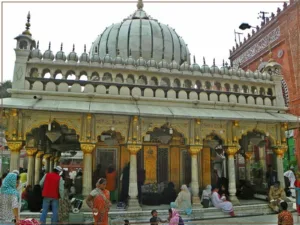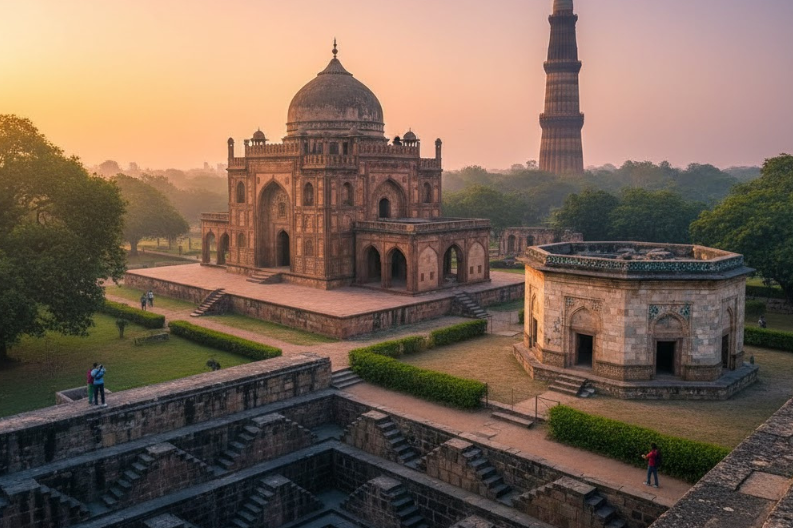The Nizamuddin Dargah Delhi is one of the most visited sites in India’s capital city. Located in Delhi’s bustling Nizamuddin West neighborhood, the shrine is dedicated to a renowned Sufi saint of the Chisti Order. This Sufi shrine honors 13th-century Indian Sufi Saint Hazrat Nizamuddin Auliya, located in Hazrat Nizamuddin Basti. Visitors to this holy site should come prepared to experience one of India’s most powerful spiritual sites and learn a bit about its rich history.
Founded in 1325, the Nizamuddin Dargah is one of the most revered Sufi shrines in India. The Dargah serves as a spiritual center for Muslims around the world and has become an essential part of life for many locals who seek blessings from the saint. Let’s take a closer look at this historical site.
History of the Dargah
The Dargah is not only a place of worship for people from all faiths, but it’s also a living testament to the teachings of Hazrat Nizamuddin Auliya. The Dargah was founded by Hazrat Khwaja Syed Nizamuddin Auliya, who was born in Badaun (Uttar Pradesh) around 1238 AD. The saint died in 1325 CE in Delhi.

During his lifetime, he preached peace and understanding between different religions, as well as patience and contentment in life. He believed that faith should be centered on God alone, not on any man or woman.
He went on to become one of India’s most prominent Muslim saints and established his own order known as “Chishtiya Sabiriya.” His teachings spread far and wide, and he attracted many followers, including Emperor Akbar and Amir Khusrau (the famous poet).
When he passed away in 1325, he was buried inside his dargah complex, which soon became a pilgrimage site for devotees from all over India and beyond. His teachings have been embraced by millions of people across India, making the Dargah a revered part of Indian culture.
The Dargah Complex
The Complex itself consists of several buildings, including two tombs, that of Hazrat Khwaja Syed Nizamuddin Auliya and Amir Khusrau, two mosques, a Sarai (rest house), a baoli (stepwell), and numerous smaller structures such as kiosks and pavilions.
The main entrance gate is made up of white marble arches topped with a green dome, while its inner courtyard offers visitors a peaceful ambiance with its lush gardens, fountains, and benches. Every Thursday evening, qawwali performances are held here, which attract large crowds from all over the Delhi-NCR region as well as people from all corners of the world.
What to Expect When Visiting the Dargah?
When visiting the Dargah, visitors can expect to witness qawwali music being performed as part of special ceremonies held throughout the year. Qawwali is an Islamic form of devotional music that has been performed at Sufi shrines for centuries.

People from all over the world gather here to take part in these ceremonies, which are often very emotional experiences for all involved. There are also many small shops selling food and souvenirs outside the dargah complex, allowing visitors to fully immerse themselves in this unique cultural experience.
Spiritual Significance
Nizamuddin Dargah is more than just a place to visit; it serves as an important spiritual center for devotees across India as well as outside India, where they come to seek blessings from Hazrat Khwaja Syed Nizamuddin Auliya through prayers.
It is believed that if you ask for something with sincerity, then your prayers will be answered by him eventually. This belief has been passed down through generations and continues even today.
People also come here to pay their respects to Amir Khusrau, whose tomb lies next to that of Hazrat Khwaja Syed Nizamuddin Auliya. For those looking for a unique spiritual experience, exploring Nizamuddin Dargah Delhi is an absolute must-do when visiting India’s capital city.
Not only does it offer an opportunity to learn more about Sufism and its important role within Indian culture, but it also provides a chance for visitors to witness traditional qawwali performances firsthand. This is something that cannot be experienced anywhere else in the world.

When To Visit?
The devotees of Nizamuddin Dargah Delhi can visit this shrine from 5: 00 am to 10:00 pm. The mosque is open to everyone, and people from all religions can visit and take the blessings of the saint.
Final Thoughts
The Nizamuddin Dargah holds immense historical significance not only because it has been standing since 1325 but also because it serves as an important spiritual center for millions of devotees across India. They come here seeking blessings from Hazrat Khwaja Syed Nizamuddin Auliya or simply to pay their respects to Amir Khusrau, who lies buried nearby.
Whether it be during qawwali performances on Thursdays or simply visiting the many monuments within its Complex, there’s something special about this holy site that makes it truly unique among other pilgrimages sites throughout India.
Whether you’re looking for spiritual enlightenment or simply want to explore one of India’s heritage sites, visiting religious sites such as Pracheen Hanuman Mandir, Gauri Shiv Mandir, Shishganj Gurudwara, Hazrat Nizamuddin Dargah, etc. will certainly be an unforgettable experience. If you ever find yourself in Delhi, then make sure you don’t miss out on visiting this incredible Shrine in Delhi!



